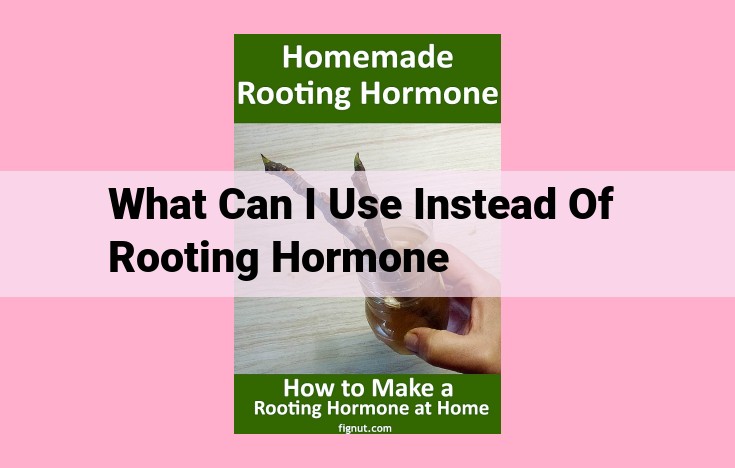Natural Root Growth Techniques For Plant Cuttings: Promoting Healthy Root Formation

In lieu of rooting hormone, various techniques can promote root growth in cuttings. Air layering allows new roots to form while attached to the parent plant. Eggshells provide essential nutrients, and humic acid enhances nutrient absorption. Mechanical wounding encourages callus formation and root growth. Mycorrhizal fungi establish a beneficial relationship for increased nutrient uptake and root growth. Rooting gels and powders directly apply hormones and moisture to cuttings. Willow water contains natural hormones that stimulate root formation.
Essential Plant Hormones: The Key to Successful Rooting
When it comes to nurturing new plant life, rooting is paramount. But did you know that a behind-the-scenes dance of plant hormones orchestrates this crucial process? Let’s delve into the botanical world and uncover the essential role of auxins and cytokinins in rooting.
Auxins: The Root-Promoting Champion
Auxins, like IAA, act as the masterminds behind root development. They regulate cell division and elongation, kicking off the formation of those all-important root initials. These tiny structures eventually grow into the robust root systems that anchor your plants and fuel their growth.
Cytokinins: The Balancing Act
Cytokinins, on the other hand, play a balancing role in rooting. They work alongside auxins, promoting cell division and influencing the emergence of lateral roots. This delicate dance between auxins and cytokinins creates the ideal environment for rooting success.
Effective Rooting Techniques to Nurture Plant Growth
In the realm of horticulture, the pursuit of thriving plants often begins with establishing a robust root system. This intricate network serves as the plant’s lifeline, anchoring it firmly in the soil while absorbing essential nutrients and water. To facilitate the development of a healthy root system, gardeners rely on a diverse arsenal of techniques that harness the power of hormones and provide optimal conditions for root growth.
One time-tested method is air layering, where a portion of a stem is girdled (partially cut) while still attached to the parent plant. This technique encourages roots to form at the wound site, allowing for new growth without detaching the cutting from its initial support. Another innovative approach involves eggshells, which provide a rich source of calcium and other minerals vital for root development. Simply crush eggshells and mix them into the potting soil or around the base of cuttings to boost their nutrient intake.
For those seeking a more controlled approach, granular or liquid rooting hormones offer a powerful solution. These synthetic preparations contain auxins, natural plant hormones that stimulate root formation. By applying rooting hormones directly to cuttings before planting, gardeners can significantly increase the chances of successful root development.
Unlocking the potential of humic acid is another effective strategy. This natural substance enhances the soil’s ability to absorb and retain nutrients, which in turn promotes root absorption and overall plant growth. Incorporating humic acid into the potting mix or using it as a root drench nourishes the roots and optimizes nutrient uptake.
Mechanical wounding may seem counterintuitive, but it plays a crucial role in stimulating root growth. By creating small cuts or scrapes on the stem or root, gardeners trigger the formation of a callus – a protective tissue that promotes healing and initiates root formation.
Harnessing the power of nature, mycorrhizal fungi form a mutually beneficial relationship with plants. These microscopic organisms attach themselves to the roots, extending their reach into the soil and increasing the plant’s access to nutrients and water. The presence of mycorrhizal fungi enhances root growth and resilience, promoting overall plant health.
For cuttings that require additional support, rooting gels provide a combination of moisture and hormones directly to the wound site. These gels create a humid environment that facilitates root formation while delivering essential nutrients and promoting cell division.
Rooting powders, a dry form of hormone preparation, offer a convenient alternative to rooting gels. By dipping cuttings into rooting powder before planting, gardeners can stimulate root growth and increase the chances of successful propagation.
Seed propagation, the natural process of starting plants from seeds, also involves root development. Seeds contain an embryo with a tiny root that emerges during germination. Providing the right conditions for seed germination, such as proper moisture and temperature, ensures optimal root growth from the outset.
Stem cutting is another widely used technique in horticulture. By taking cuttings from stems and propagating them into new plants, gardeners can replicate specific plant characteristics and maintain genetic diversity. Stem cuttings develop new roots to establish themselves as independent plants.
Finally, willow water, derived from the branches of willow trees, contains a natural hormone called salicylic acid that has been shown to promote root growth. Soaking cuttings in willow water or using it as a rooting solution can enhance root development and improve the overall success rate of propagation.
By understanding the essential plant hormones and employing these effective rooting techniques, gardeners can foster the development of robust root systems that anchor their plants firmly, facilitate nutrient absorption, and ultimately promote plant health and vitality.